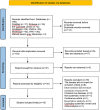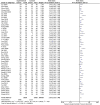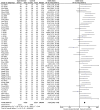Efficacy and safety of tongxinluo capsule for angina pectoris of coronary heart disease: an overview of systematic reviews and meta-analysis
- PMID: 38414926
- PMCID: PMC10896841
- DOI: 10.3389/fcvm.2024.1229299
Efficacy and safety of tongxinluo capsule for angina pectoris of coronary heart disease: an overview of systematic reviews and meta-analysis
Abstract
Background: Tongxinluo capsule (TXLC) is a common drug for treating angina pectoris of coronary heart disease (CHD). In recent years, many systematic reviews (SRs) and meta-analyses (MAs) have reported the efficacy and safety of TXLC for improving angina symptoms in patients with CHD. We aimed to comprehensively evaluate the existing SRs and MAs of TXLC in treating angina pectoris of CHD, summarize the evidence quality, and provide scientific evidence and recommendations.
Methods: We searched seven databases for relevant SRs/MAs published up to 1 June 2023. Two reviewers independently completed the literature retrieval, screening, and data extraction. We used A Measurement Tool to Assess Systematic Reviews 2 (AMSTAR 2) to evaluate the methodological quality, the Risk of Bias in Systematic Reviews (ROBIS) to assess the risk of bias, and the Grading of Recommendations Assessment, Development and Evaluation (GRADE) to determine the strength of the evidence. RevMan 5.3 was used to synthesize data.
Results: We identified 15 SRs/MAs, including 329 RCTs and 33,417 patients. According to the evaluation results of AMSTAR-2, only one SR was of high methodological quality, the others were very low. ROBIS assessment showed that one SR (6.67%) had a low risk, 3 SRs (20%) had an unclear risk, and 11 SRs (73.33%) had a high risk. We assessed 42 outcomes by the GRADE, 10 (23.81%) for moderate-quality evidence, 17 (40.48%) for low-quality evidence, and 15 (35.71%) for very-low-quality evidence. Mate-analysis showed that TXLC combined with conventional western medications improved electrocardiogram efficacy (RR = 1.38, 95% CI: 1.23-1.43, P < 0.001) and angina efficacy (OR = 3.58, 95% CI: 3.02-4.24, P < 0.001), reduced angina attack frequency (SMD = -0.54, 95% CI: -0.64 to -0.44, P < 0.001) and angina duration (SMD = -0.42, 95% CI: -0.57 to -0.28, P < 0.001), with general heterogeneity. The pooled results showed that TXLC appears to have some efficacy in improving cardiac function and relieving angina symptoms, but there is limited evidence that it improves cardiovascular event rates, hemorheology, lipids, or hs-CRP. In the assessment of drug safety, TXLC was associated with different degrees of adverse drug reactions.
Conclusion: Based on the evidence, TXLC may be effective as an adjuvant treatment for angina pectoris of CHD. However, the quality of the evidence is low, and the drug's safety must be carefully interpreted. In future studies, high-quality randomized controlled trials are needed to confirm the effectiveness and safety of TXLC.
Systematic review registration: http://www.crd.york.ac.uk/PROSPERO/, identifier (CRD42022365372).
Keywords: angina pectoris; coronary heart disease; overview; tongxinluo capsule; traditional Chinese medicine.
© 2024 Li, Feng, Zhou, Luo, Deng, Gan, Wu, Zhu and Zhou.
Conflict of interest statement
The authors declare that the research was conducted in the absence of any commercial or financial relationships that could be construed as a potential conflict of interest.
Figures










Similar articles
-
Tongxinluo Capsule Combined with Atorvastatin for Coronary Heart Disease: A Systematic Review and Meta-Analysis.Evid Based Complement Alternat Med. 2021 Jul 17;2021:9413704. doi: 10.1155/2021/9413704. eCollection 2021. Evid Based Complement Alternat Med. 2021. PMID: 34335841 Free PMC article. Review.
-
Efficacy and Safety of Tongxinluo Capsule as Adjunctive Treatment for Unstable Angina Pectoris: A Systematic Review and Meta-Analysis of Randomized Controlled Trials.Front Pharmacol. 2021 Oct 11;12:742978. doi: 10.3389/fphar.2021.742978. eCollection 2021. Front Pharmacol. 2021. PMID: 34707500 Free PMC article. Review.
-
Effectiveness and safety of acupuncture for angina pectoris: An overview of systematic reviews.Integr Med Res. 2022 Sep;11(3):100864. doi: 10.1016/j.imr.2022.100864. Epub 2022 Apr 6. Integr Med Res. 2022. PMID: 35535308 Free PMC article. Review.
-
Efficacy and Safety of Different Courses of Tongxinluo Capsule as Adjuvant Therapy for Coronary Heart Disease after Percutaneous Coronary Intervention: A Systematic Review and Meta-Analysis of Randomized Controlled Trials.J Clin Med. 2022 May 25;11(11):2991. doi: 10.3390/jcm11112991. J Clin Med. 2022. PMID: 35683377 Free PMC article. Review.
-
Evidence quality assessment of sodium tanshinone IIA sulfonate injection intervention coronary heart disease angina pectoris: An overview of systematic reviews and meta-analyses.Medicine (Baltimore). 2023 Nov 3;102(44):e35509. doi: 10.1097/MD.0000000000035509. Medicine (Baltimore). 2023. PMID: 37933033 Free PMC article. Review.
Cited by
-
Chinese and western medicine treatment of myocardial fibrosis drugs.Front Cardiovasc Med. 2025 Jan 15;11:1477601. doi: 10.3389/fcvm.2024.1477601. eCollection 2024. Front Cardiovasc Med. 2025. PMID: 39882321 Free PMC article. Review.
References
-
- Chinese Cardiovascular Health and Disease Report Compilation Group. Summary of the China cardiovascular health and disease report 2021. Chin J Circ. (2022) 37(6):553–78. 10.3969/j.issn.1000-3614.2022.06.001 - DOI
Publication types
LinkOut - more resources
Full Text Sources
Research Materials
Miscellaneous

